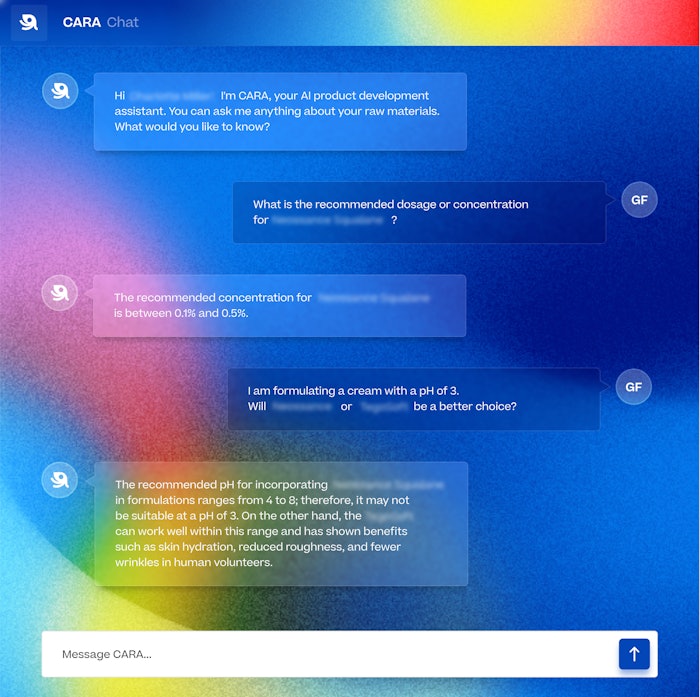
“What steam was to the First Industrial Revolution is what AI will be to the fourth,” McKinsey noted earlier this year. “And much as coal supply chains and factory infrastructure were the tipping point that enabled steam power to race up the adoption curve, data collection and data infrastructure are doing the same in the fourth.”
As with the wider economy, beauty innovation seems poised to accelerate with new AI-powered tools that allow users to chat with a virtual consultant, reverse engineer products, build new products to a wide array of regulatory, sustainability and retailer requirements, anticipate consumer liking based on reviews of existing similar products, and much more.
This is particularly critical amid emerging regulatory requirements such as MoCRA and ever-changing consumer demands.
These tools, an advancement from legacy systems that rely on Excel tables or cumbersome non-cloud-based databases, can also give a competitive edge to smaller upstart players and early adopters alike.
Here’s what that looks like in practice.
From Consumer Consultant to Product Innovation Platform
The Good Face Project entered the consumer education space with a data-rich, cloud-based solution that allowed shoppers to assess the safety of products based on ingredient compositions.
While the firm was not the first solution to deliver greater transparency, the firm’s cloud-based system was less clunky than earlier solutions in the market.
Since its debut in 2018, The Good Face Project has expanded to a business solution, allowing retailers to create interfaces for shoppers seeking guidance on product selection.
It has also developed solutions for contract manufacturers and ingredient suppliers.
By connecting the entire value chain of beauty, The Good Face Project has now produced a product innovation platform powered by the cloud and AI.
CARA Chat: a ChatGPT for Beauty
The Good Face Project’s new CARA Chat—powered by CARA AI, the company’s proprietary artificial intelligence—is a real-time communication tool similar to ChatGPT, but trained solely on beauty-centric natural language.
By strictly limiting the chat tool’s training, the company has ensured responses are tailored for industry professionals.
CARA Chat adds to The Good Face Project’s existing product lifecycle management (PLM) solutions and was built using proprietary data models and information drawn from the company’s existing databases, including ingredient supplier portals.
Clients can also input their own data. That information remains confidential and wholly owned by the customer.
The AI chat system draws from this data and documents in any format to reply to queries about beauty regulations, performance, and information related to the ingredients of a formula or raw material.
The chat tool can, for example, inform a user which components of a shampoo formula have allergenic concerns. To take another example, CARA Chat can also help users determine defensible product claims.
In all cases, The Good Face Project says, answers are precise and instantaneous.
The Good Face Project argues that CARA Chat can help product innovation teams, sales leads and other beauty professionals move quickly.
Reverse Engineering Beauty at Speed
 The Good Face Project’s Reverse Engineering Module, for example, purports to speed up the R&D formulation development process by allowing users to upload a full list of ingredients—for instance one copied and pasted from a retailer website—and use that list to recreate the formula by pulling information from a database of more than 40,000 trade-named materials.The Good Face Project
The Good Face Project’s Reverse Engineering Module, for example, purports to speed up the R&D formulation development process by allowing users to upload a full list of ingredients—for instance one copied and pasted from a retailer website—and use that list to recreate the formula by pulling information from a database of more than 40,000 trade-named materials.The Good Face Project
The Good Face Project’s Reverse Engineering Module, for example, purports to speed up the R&D formulation development process by allowing users to upload a full list of ingredients—for instance one copied and pasted from a retailer website—and use that list to recreate the formula by pulling information from a database of more than 40,000 trade-named materials.
The reverse-engineered formula can be consulted to identify the purpose of ingredients and can be adjusted to tweak formula price or swap out any ingredients that send up red flags for regulatory, safety or other concerns.
Users can also customize formulas by adjusting concentrations or swapping out materials to increase efficacy or optimize price.
And, for beauty detectives, assessing ingredient compositions against market ingredients can uncover which specific captive materials a competitor is using.
Users of the system can also read the “mood” of product reviews correlated with specific claim benefits or compositions, allowing product developers to anticipate shopper “liking.”
In addition to reverse engineering or benchmarking products, the module can also reportedly help brands and contract manufacturers accelerate ingredient discovery and identify new suppliers.
In all, The Good Face Project believes the module allows teams to arrive at market-ready formulas in seconds.
AI-powered Innovation Begins with Good Data
Underlying The Good Face Project’s technology is the company’s data. Notably, its Ontology Search Module comprises more than 140,000 molecules, including ingredient properties, related research papers, and safety info and regulatory compliance data such as impurity profiles.
This underlying database supports The Good Face Project’s predictive algorithms to support innovation decision-making processes for brands, contract manufacturers and ingredient manufacturers.
Combined, tools such as these can help brands of every scale move more quickly by leveraging accurate, timely data in a user-friendly interface.
“Identifying 140,000,000 molecules was not the biggest hurdle: the processing and structuring of such a large data graph is what other companies are not able to do today,” says Iva Teixeira, co-founder and CEO of Good Face Project.
“Indeed, we leverage our own proprietary AI, CARA, that is helping us 24/7 to manage our data at an unprecedented speed and efficiency,” adds Lena Skliarova-Mordvinova, cofounder and CTO of Good Face Project.










